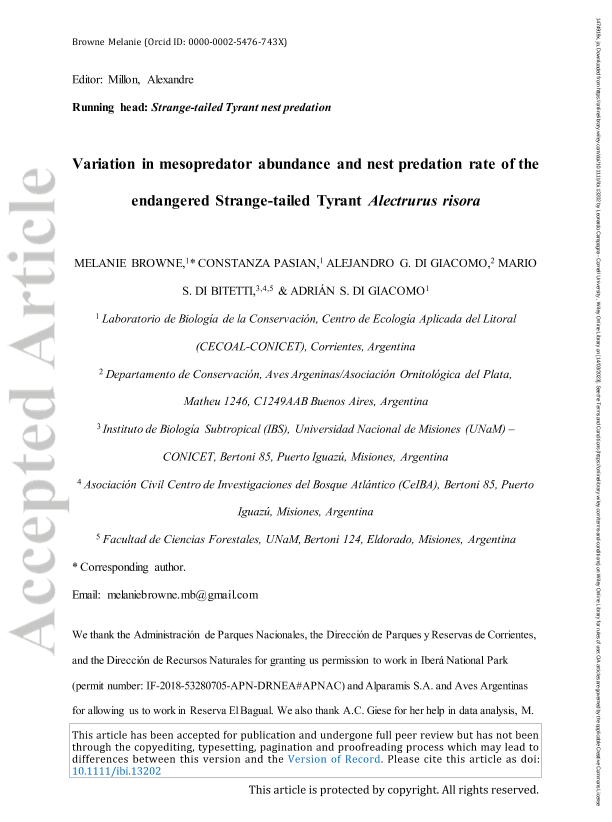Mostrar el registro sencillo del ítem
dc.contributor.author
Browne, Melanie

dc.contributor.author
Pasian, Constanza

dc.contributor.author
Di Giacomo, Alejandro G.

dc.contributor.author
Di Bitetti, Mario Santiago

dc.contributor.author
Di Giacomo, Adrian Santiago

dc.date.available
2024-02-08T09:51:08Z
dc.date.issued
2023-03
dc.identifier.citation
Browne, Melanie; Pasian, Constanza; Di Giacomo, Alejandro G.; Di Bitetti, Mario Santiago; Di Giacomo, Adrian Santiago; Variation in mesopredator abundance and nest predation rate of the endangered Strange‐tailed Tyrant Alectrurus risora; Wiley Blackwell Publishing, Inc; Ibis; 165; 4; 3-2023; 1201-1216
dc.identifier.issn
0019-1019
dc.identifier.uri
http://hdl.handle.net/11336/226231
dc.description.abstract
Nest predation is the main cause of nest failure in passerine birds and thus is a key determinant of breeding traits. Accordingly, nest predator community composition and abundance modulate nest predation rates. When top predators are absent, mesopredator populations may become unchecked, which in turn increases the predation pressure on their prey species. We evaluated whether nest predator abundance and breeding traits of an endangered grassland bird, the Strange-tailed Tyrant Alectrurus risora, differed between two protected areas: Iberá National Park (INP), where top predators have been extinct for 50 years, and Reserva El Bagual (REB), where Pumas Puma concolor still have a stable population. We measured abundances of potential nest predator species and during the 2015–2018 breeding seasons we monitored Strange-tailed Tyrant nests and set camera traps to identify nest predators. Mesopredator abundance was higher in INP, and foxes were identified as the main nest predators. Nest predation rate was also higher in INP, where the daily nest predation rate and cumulative probability of nest predation were 0.05 ± 0.006 and 0.81, whereas in REB they were 0.04 ± 0.004 and 0.70, respectively. The 10-fold higher frequency of fox records in INP could explain the higher nest predation rate observed, suggesting that the extinction of top predators may increase nest predation rates of endangered grassland birds in protected areas through release of native mesopredator species. The lower nest predation observed in REB was compensated for by a higher nest abandonment rate, which resulted in a similar fledgling production in the two study sites. Clutch size, hatching success and number of nestlings did not differ between study sites. The low breeding success recorded for this endangered species despite its populations being in protected areas of high conservation value is alarming given the global decline that grassland bird populations are facing.
dc.format
application/pdf
dc.language.iso
eng
dc.publisher
Wiley Blackwell Publishing, Inc

dc.rights
info:eu-repo/semantics/openAccess
dc.rights.uri
https://creativecommons.org/licenses/by-nc-sa/2.5/ar/
dc.subject
BREEDING BIOLOGY
dc.subject
CAMERA TRAP
dc.subject
MESOPREDATOR RELEASE
dc.subject
NEST CONCEALMENT
dc.subject
NEST PREDATORS
dc.subject
SUBTROPICAL GRASSLANDS
dc.subject.classification
Ecología

dc.subject.classification
Ciencias Biológicas

dc.subject.classification
CIENCIAS NATURALES Y EXACTAS

dc.title
Variation in mesopredator abundance and nest predation rate of the endangered Strange‐tailed Tyrant Alectrurus risora
dc.type
info:eu-repo/semantics/article
dc.type
info:ar-repo/semantics/artículo
dc.type
info:eu-repo/semantics/publishedVersion
dc.date.updated
2024-02-02T15:10:42Z
dc.journal.volume
165
dc.journal.number
4
dc.journal.pagination
1201-1216
dc.journal.pais
Reino Unido

dc.journal.ciudad
Londres
dc.description.fil
Fil: Browne, Melanie. Consejo Nacional de Investigaciones Científicas y Técnicas. Centro Científico Tecnológico Conicet - Nordeste. Centro de Ecología Aplicada del Litoral. Universidad Nacional del Nordeste. Centro de Ecología Aplicada del Litoral; Argentina
dc.description.fil
Fil: Pasian, Constanza. Consejo Nacional de Investigaciones Científicas y Técnicas. Centro Científico Tecnológico Conicet - Nordeste. Centro de Ecología Aplicada del Litoral. Universidad Nacional del Nordeste. Centro de Ecología Aplicada del Litoral; Argentina
dc.description.fil
Fil: Di Giacomo, Alejandro G.. No especifíca;
dc.description.fil
Fil: Di Bitetti, Mario Santiago. Consejo Nacional de Investigaciones Científicas y Técnicas. Centro Científico Tecnológico Conicet - Nordeste. Instituto de Biología Subtropical. Instituto de Biología Subtropical - Nodo Puerto Iguazú | Universidad Nacional de Misiones. Instituto de Biología Subtropical. Instituto de Biología Subtropical - Nodo Puerto Iguazú; Argentina
dc.description.fil
Fil: Di Giacomo, Adrian Santiago. Consejo Nacional de Investigaciones Científicas y Técnicas. Centro Científico Tecnológico Conicet - Nordeste. Centro de Ecología Aplicada del Litoral. Universidad Nacional del Nordeste. Centro de Ecología Aplicada del Litoral; Argentina
dc.journal.title
Ibis

dc.relation.alternativeid
info:eu-repo/semantics/altIdentifier/url/https://onlinelibrary.wiley.com/doi/10.1111/ibi.13202
dc.relation.alternativeid
info:eu-repo/semantics/altIdentifier/doi/http://dx.doi.org/10.1111/ibi.13202
Archivos asociados
